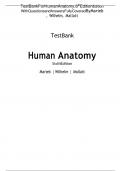Exam (elaborations)
TEST BANK FOR HUMAN ANATOMY, SIXTH EDITION BY MARIEB, WILHELM, MALLATT BY RENNEE A. MOORE MOORE, RENNEE A.
- Institution
- Chamberlain College Of Nursing
TEST BANK FOR HUMAN ANATOMY, SIXTH EDITION BY MARIEB, WILHELM, MALLATT BY RENNEE A. MOORE MOORE, RENNEE A.
[Show more]




